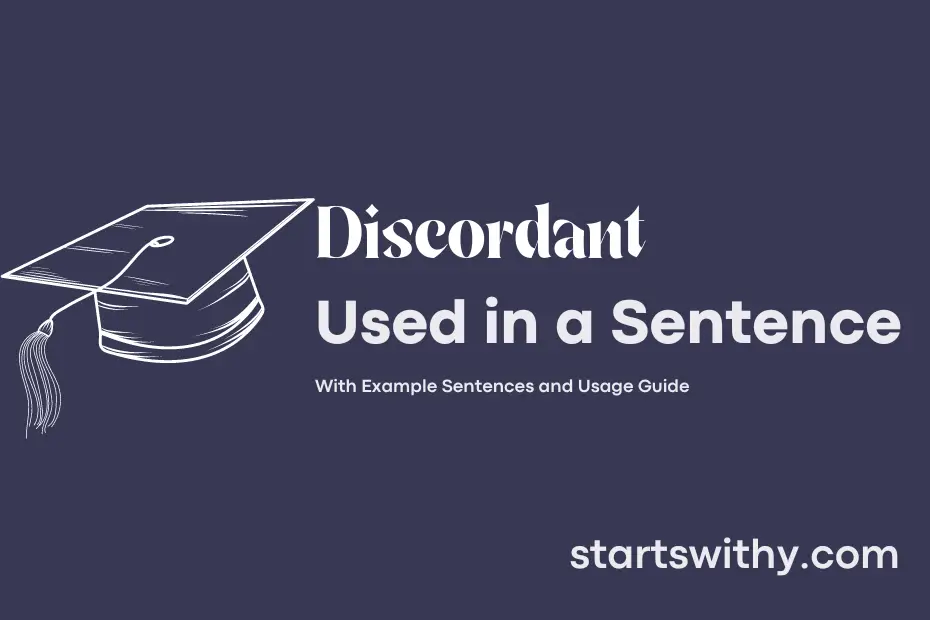Have you ever come across a discordant combination of words or sounds that just didn’t seem to fit together? When elements clash or oppose each other in a jarring manner, creating a sense of disharmony or disagreement, it can be described as discordant.
In linguistics, the term “discordant” is used to characterize sentences or phrases that lack harmony or unity, often due to conflicting ideas, tones, or styles. This clash can create a striking effect or highlight a tension within the text, making it a useful tool for conveying complex emotions or messages.
7 Examples Of Discordant Used In a Sentence For Kids
- The discordant sounds of the drums made the children cover their ears.
- The birds chirped a discordant tune in the morning.
- The wind and rain created a discordant noise outside.
- The cats were yowling in a discordant manner last night.
- The discordant music from the radio made the baby cry.
- The cars honking in traffic created a discordant symphony.
- The children’s laughter turned into a discordant yelling match.
14 Sentences with Discordant Examples
-
As the final exam approached, the study group’s opinions on the best revision strategy became more discordant.
-
The discordant music blaring from the party next door made it impossible to focus on my assignments.
-
The students’ discordant views on the topic led to a heated debate during the class discussion.
-
The group project suffered due to the team members’ discordant work schedules and conflicting priorities.
-
The discordant mix of languages spoken in the cafeteria created a multicultural atmosphere on campus.
-
The professor’s discordant feedback on our essays left us confused about how to improve our writing.
-
The student body’s discordant reactions to the campus renovation plans highlighted the importance of open communication.
-
Despite their discordant perspectives on social issues, the college students found common ground in their desire for positive change.
-
The discordant notes of the violinist during the music concert disrupted the harmonious atmosphere in the auditorium.
-
The discordant opinions on the effectiveness of online learning platforms sparked a lively discussion among the students.
-
The discordant tones in the group dynamics were resolved through open and honest communication among the members.
-
The discordant weather patterns in the city caused confusion among college students trying to plan outdoor activities.
-
The discordant schedules of the college students made it challenging to find a suitable time for group study sessions.
-
The discordant voices in the student council meeting emphasized the need for compromise and collaboration to reach a consensus.
How To Use Discordant in Sentences?
Discordant **is used to describe things that are not in agreement or harmony with each other. When incorporating the word discordant into a sentence, it is important to ensure that it accurately conveys a lack of agreement or harmony between the elements mentioned. Here’s how to use discordant in a sentence for beginners:
- Example: The music at the party was discordant, with different songs playing at the same time, creating a chaotic atmosphere.
It’s essential to consider the context in which you are using the word discordant to ensure that it effectively communicates the lack of harmony or agreement between the elements being described. By practicing using the word in various sentences, you can become more comfortable incorporating it into your vocabulary.
- Example: The couple’s opinions on the movie were discordant, as one loved it while the other found it dull and uninteresting.
Remember that the word discordant is used to highlight conflicting or contrasting elements and should be used in situations where there is a clear lack of harmony or agreement. With practice and familiarity, you will be able to use discordant effectively to enhance your communication skills and convey your intended meaning clearly.
Conclusion
In conclusion, sentences with discordant elements can confuse readers and disrupt the flow of writing. These sentences often contain conflicting or mismatched ideas, creating a sense of dissonance that detracts from the coherence and effectiveness of the communication. Writers should strive to create sentences that are clear, cohesive, and harmonious to ensure that their message is easily understood and well-received.
To avoid discordant sentences, writers should pay close attention to how their ideas are structured and presented. Consistent use of tone, style, and grammar can help maintain a coherent narrative and make the writing more engaging for the audience. By crafting sentences that are balanced and consistent in their structure and content, writers can effectively convey their message and connect with their readers on a deeper level.



